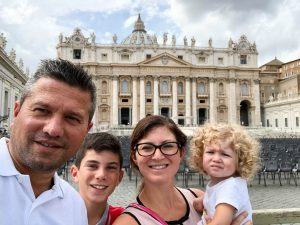Can Rome be done in one day? Why it takes at least 3 days to live like a Roman
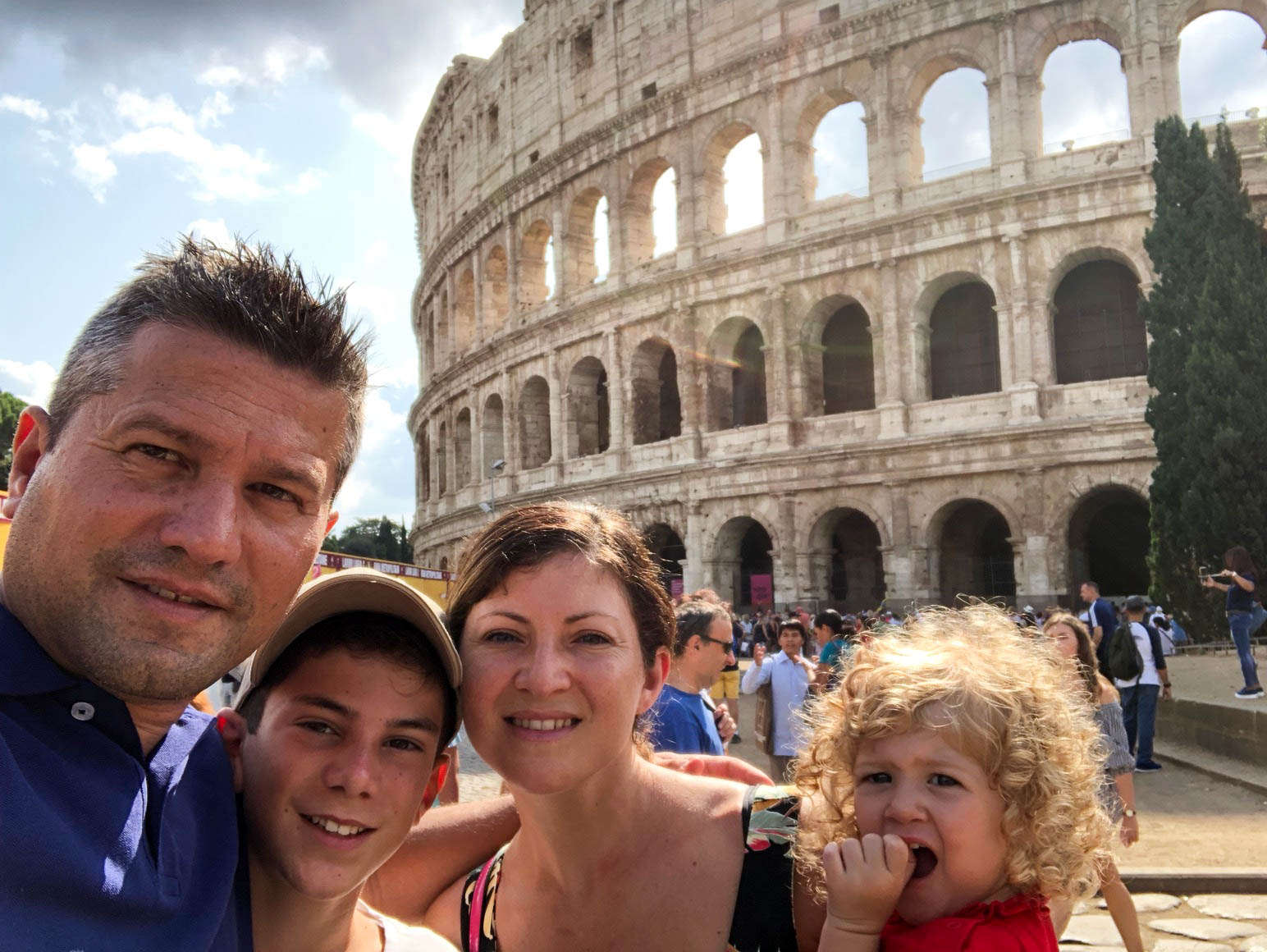
Day 1:
I wake up in my luxury hotel room at Hotel Hassler which has a magical location in the heart of Rome’s City Centre at the top of the Spanish Steps. I must say when it comes to luxury accommodation, Hotel Hassler is right up there with the best of the best. It’s September and the warm weather from Summer lingers.
One of the highlights would have to be breakfast at Hassler Bistrot at Palm Court. There is an aroma of coffee and pastry as we are escorted to our table. Simone my husband and I order the traditional breakfast coffee, a cappuccino – what else? I decide to indulge in a traditional Italian breakfast, a ‘cornetto alla crema’ (Italian croissant filled with crema pasticciera) and other freshly baked pastries.
We plan what sights we want to see for the day. Given the location of our fabulous hotel, we head down the ‘Scalinata di Trinità dei Monti’ (The Spanish Steps), a 135 step staircase to get between the Piazza di Spagna which is at the base of the Spanish Steps and Piazza Trinità dei Monti at the top where the hotel is located to the right. There are also more steps to get to the Roman highlight Trinità dei Monti church from the Piazza Trinità dei Monti at the top of the Spanish steps. Over the course of our 3 days in Rome my family have been up and down this monumental set of steps many times.
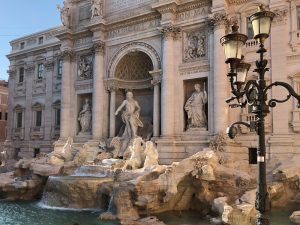 We walk to the ‘Fontana di Trevi’ (Trevi Fountain), the world’s largest Baroque fountain completed in 1762. The Trevi fountain is not only the most beautiful fountain in Rome, but the most magnificent fountain worldwide. It is famous for the tradition of coin throwing. The saying goes that if you throw one coin using your right hand over your left shoulder into the Trevi Fountain that you will return to Rome. If you throw a second coin, the saying goes that you will have a new romance with a Roman (apparently works for males and females) and a third coin will ensure a marriage with him/her. This coin tossing tradition dates back to the 19th century. I believe in traditions and given that I am blessed with a wonderful husband and two beautiful children, I happily toss one coin into the Trevi Fountain to boost my chances of returning to this magical city.
We walk to the ‘Fontana di Trevi’ (Trevi Fountain), the world’s largest Baroque fountain completed in 1762. The Trevi fountain is not only the most beautiful fountain in Rome, but the most magnificent fountain worldwide. It is famous for the tradition of coin throwing. The saying goes that if you throw one coin using your right hand over your left shoulder into the Trevi Fountain that you will return to Rome. If you throw a second coin, the saying goes that you will have a new romance with a Roman (apparently works for males and females) and a third coin will ensure a marriage with him/her. This coin tossing tradition dates back to the 19th century. I believe in traditions and given that I am blessed with a wonderful husband and two beautiful children, I happily toss one coin into the Trevi Fountain to boost my chances of returning to this magical city.
The next stop is the Pantheon, an ancient Roman monument of almost 2000 years and so well preserved. The Pantheon was originally built as a temple to the Roman gods, then converted as a Christian church.
We then visit Piazza Navona, one of the most beautiful piazzas in the world and famous for it’s ‘Fontana dei Quattro Fiumi’ (Fountain of Four Rivers), created in 1651 by Gian Lorenzo Bernini.
After a long day of walking and sightseeing, the family freshen up and head to Hassler Bistrot at Palm Court for dinner. At the back of our mind we are thinking Rome is the birthplace of 4 famous pastas – we should try at least one of them. So, what are the 4 famous pastas in Rome? Spaghetti alla carbonara (the real Carbonara, not the pasta with cream that you may be thinking of), Spaghetti Cacio e pepe, Pasta alla gricia and Bucatini/ mezze maniche all’amatriciana. Interestingly 3 out of these 4 pastas contain Guanciale (but you could also use Pancetta as a substitute). We order the award-winning and unforgettable Mezze maniche all’amatriciana. If you are in Rome, do stop by Hotel Hassler and order it – it’s incredible. If you are outside of Rome, do not despair. Click on the link to try Italian Spoon’s Roman inspired recipe for Bucatini pasta all’ amatriciana.
Day 2:
Have you ever wondered what Vatican City is like? It’s day 2 and we are so excited to be travelling to the official residence of the Pope and the smallest but most well-known countries in the world.
Thankfully we prearranged with the hotel to have skip-the-line tickets to visit the ‘Musei Vaticani’ (Vatican Museums), the home of approximately 70,000 works. There are 54 galleries in total which display remarkable sculptures, frescos, religious and other works of art, even a fabulous gallery of Italian maps. The last sala and without a doubt the highlight of the museum is the ‘Cappella Sistina’ (Sistine Chapel). From Michelangelo’s painted ceiling in the chapel to the frescos that decorate the walls, I am blown away by the outstanding talent and the stories that the art depicts. I am going to share some inside info with you. The Sistine Chapel has an unmarked door to the far right end of the chapel from where you enter. It is supposed to be for tour groups only and provides skip the queue access to St. Peters Basilica. I recommend you go through this door after visiting the Sistine Chapel.
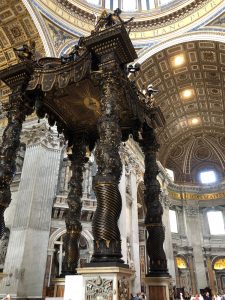
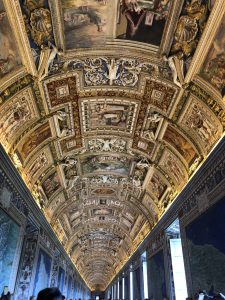 Our next step is the ‘Basilica Papale di San Pietro in Vaticano’ (St. Peter’s Basilica), the largest and most impressive basilica in the world. I was blown away by the vast dimensions as I step into the interior of St. Peter’s Basilica. Everything from the marble used, sculptures including Michelangelo’s ‘Pieta’ and artwork are so beautiful. The exterior of St. Peter’s Basilica is also impressive, as is St. Peter’s Square, a large piazza directly in front of St. Peter’s Basilica and the place where great masses of people gather to see the Pope deliver his blessing.
Our next step is the ‘Basilica Papale di San Pietro in Vaticano’ (St. Peter’s Basilica), the largest and most impressive basilica in the world. I was blown away by the vast dimensions as I step into the interior of St. Peter’s Basilica. Everything from the marble used, sculptures including Michelangelo’s ‘Pieta’ and artwork are so beautiful. The exterior of St. Peter’s Basilica is also impressive, as is St. Peter’s Square, a large piazza directly in front of St. Peter’s Basilica and the place where great masses of people gather to see the Pope deliver his blessing.
Our last stop is none other than food related. I discover that the Romans know how to find the highest quality cured/processed meats, cheeses and wine.
We stop at Paciotti Salumeria for a San Daniele Prosciutto and mozzarella panino. Their website states “After passing under the arch of Parma and San Daniele PDO raw hams, we find ourselves in a paradise of aromas and flavours …” – they are so right. Paciotti Salumeria is a must go in Rome and walking distance from the Vatican Museums.
Roman cuisine not only inspires me to make pastas (with lots of Pecorino cheese), but is also known for its lamb dishes such as Abbachio alla Romana. Try our delicious Abbachio alla Romana from anywhere in the world. Gnocchi alla Romana (Roman-style gnocchi) is also a popular dish which uses flour instead of potatoes which the regular Italian gnocchi are made of. Look out for our recipe of Gnocchi alla Romana which is coming soon.
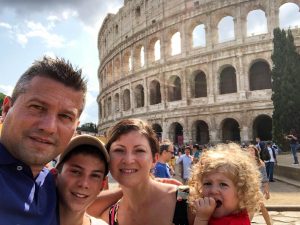 Day 3:
Day 3:
On our third and final day in Rome we head to ‘Il Colosseo’ (the Colosseum). The colosseum was the largest amphitheatre in the world. It was built in ancient Roman times 2000 years ago and was used for gladiatorial contests and public spectacles for over 500 years.
How amazing is it that this oval amphitheatre seated an extraordinary 50,000 to 80,000 people? One day, I would love to see what lies inside and beneath the colosseum walls. When my kids are older, it will be interesting to see the subterranean passageways once used to transport wild animals and gladiators.
The exterior of the Colosseum is without a doubt one of the most iconic symbols of Rome. Despite being partially ruined by earthquake, stone-robbers and fire damage, the Colosseum remains one of Rome’s most popular tourist attractions and for good reason – the remains of the Colosseum’s outer façade are breathtaking and a photo hotspot.
We returned to the hotel for lunch – what else but the rich and creamy Spaghetti alla carbonara. Try our recipe of The real Spaghetti Carbonara. Also read our blog to discover How to make the real Spaghetti alla Carbonara.
After lunch I have convinced my husband and son to go shopping (as long as I agree to buy my son clothes – son, you have a deal). We head to Via dei Condotti with high end, luxury fashion brands (for a walk and window shopping). I will warm you that on this street, even a stop for coffee at Caffe Greco will cost you an arm and a leg. I find the shops on Via del Corso and Via del Tritone to be good value and have just what I am looking for. Do expect crowds and to be walking onto the road which feels a little strange at first but totally worth a visit if you have (or make) the time – happy shopping!
So can you live like a Roman in 3 days? I hear that a traditional Roman menu consists of gnocchi (Roman-style) on Thursdays, Baccalà (dried salted cod) or other fish on Fridays and Tripe on Saturday. That is certainly one way to eat like a Roman. After 3 days we would love to extend our stay. After all, 3 days in the eternal city is not enough to see absolutely everything there is to see. I am grateful for the amazing experience and can say with confidence that 3 days are enough to experience the highlights Rome has to offer. I must come back to this city to see more…. I hope my coin toss in the Trevi fountain brings me back very soon.
Blog Can Rome be done in one day? Why it takes at least 3 days to live like a Roman authored by Vanessa Bottaro.
Vanessa Bottaro
Vanessa is Creative Director of the Italian Spoon website and Author of The Italian entertaining cookbook, a collection of home-style Italian recipes and tips for entertaining in true Italian-style. In addition to cooking and taking photographs, Vanessa writes the recipes and blogs to bring the love of Italian cooking to life! The collection of recipes and blogs on the website have been inspired by travels to Italy and desire to share what she has learnt from the great ‘Mamma’s and ‘Nonna’s in her life!
Vanessa is an entrepreneur and wife to husband Simone and the mother of two beautiful kids Dante and Mia. Even so she was born and lives in Melbourne Australia, Vanessa has a deep connection to Italy. Perhaps it is the food, or maybe it is because it is the place where Vanessa met the love of her life, Simone to whom she has been happily married for so many years.
Latest posts by Vanessa Bottaro (see all)
- Italian Christmas menu 2022 - December 16, 2022
- 10 Show-Stopping Roast Ideas - November 18, 2022
- Healthy Italian food recipes - November 4, 2022
Recent Posts
-
16 December, 2022Italian Christmas menu 2022
-
18 November, 202210 Show-Stopping Roast Ideas
-
4 November, 2022Healthy Italian food recipes
-
21 October, 2022Tips to cooking the perfect pasta (just like nonna)
-
7 October, 20226 rules to make the perfect homemade Italian soup

